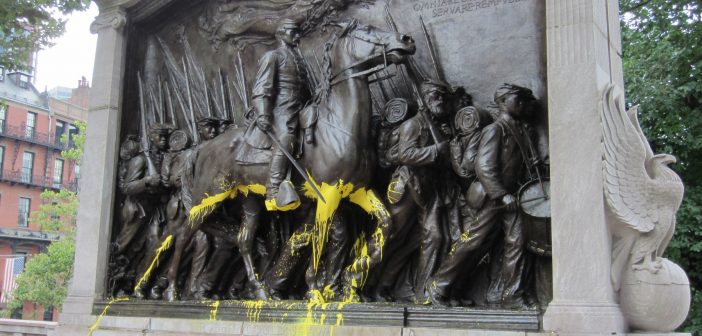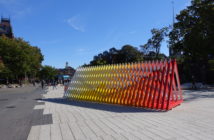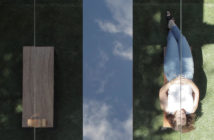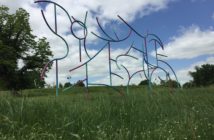One beautiful July morning in 2013 Boston woke to discover green paint had been thrown against the Robert Gould Shaw and the 54th Regiment Memorial that sits across from the State House in the Boston Public Garden. Outrage followed but questions “why?” went unanswered. Ten days later the perpetrator returned, this time during the busy afternoon, parked in the bus lane, ran through the crowd to the monument and again threw paint, this time yellow, across the recently cleaned surface. National Park Service Rangers were able to subdue the Boston woman who claimed the monument demeaned the Black soldiers because they were walking and their commanding officer was riding along side on his horse. One of the 54th re-enactment soldiers was later quoted in the Globe, "I think I feel a little sad for her because she may not know what the monument really stands for…I would like to see that person get some kind of a training course about what these men went through during the Civil War."
Boston is the home to a collection of more than 700 pieces of public art. Roughly 100 of these are American war memorials with another 300 dedicated to war heroes and other war related events. As a collection, these monuments speak volumes about Boston's history, hopefully, some of them can serve as inspiration as we move into the future.

Robert Gould Shaw and the 54th Regiment Memorial. Via Wikipedia.
Robert Gould Shaw and the 54th Regiment Memorial honors the first African-American military unit in the Union Army. This monument captures the moment that 1,000 African American soldiers proudly marched in formation, under Robert Gould Shaw’s command through the streets of Boston, with packed crowds cheering them on. The monument sits on the exact spot where, on May 28, 1863 the regiment halted for a thirteen-gun salute in front of the State House. There Governor Andrew gave the soldiers the blessing of the State before they continued to Boston Harbor and boarded ships to join their fellow Union soldiers in the south. On July 18, 1863, a little more than eight weeks later after their departure from Boston, half of the regiment and Shaw were dead, killed during a battle off the coast of South Carolina. Large amounts of African Americans enlisted in the Union Army as news of the 54th Regiment’s fate spread throughout the country.
August Saint-Gaudens, the preeminent artist of the time, was asked to design the monument to commemorate the 54th Regiment’s valiant sacrifice. It took Saint-Gaudens almost fourteen years to complete the project, driving the funders and supporters wild. In letters, Saint-Gaudens agonized over his abilities to match the importance of the men’s sacrifice, feeling a deep obligation to show Shaw with his men as a unit, together portraying the true heroic spirit of the American soldier. It must have been amazing to experience the monument’s unveiling in 1897. Many of the surviving members of the 54th Regiment were in attendance, and marched in formation, retracing their steps to their monument, where they were finally, officially welcomed home. The philosopher William James noted that the monument “was the first American soldier’s monument dedicated to a group of citizens united in the interests of their country, rather than to a single military hero.” Today the Robert Gould Shaw and the 54th Regiment is considered the greatest war memorial in the country.
Now the city is undergoing another resurgence within the creative community; the citywide development provides us with a potential opportunity to rethink our expectations of what public art can contribute to the environment and new ways to create neighborhood identity. Temporary art is a viable alternative to permanent work, and can be used as a community builder to stimulate conversation and make new connections. Temporary art offers us the ability to have immediate translation of current events and renew and reinvigorate historic settings.
The Massachusetts Military Heroes Fund sponsors the annual Memorial Day installation along the side of Flagstaff Hill in the Boston Common. Each year over Memorial Day weekend, about 600 volunteers plant flags— each representing a Massachusetts service man or women who has lost their life in the line of duty from the Civil War through present day. Last year they planted over 37,000 flags in this powerful and elegant remembrance.
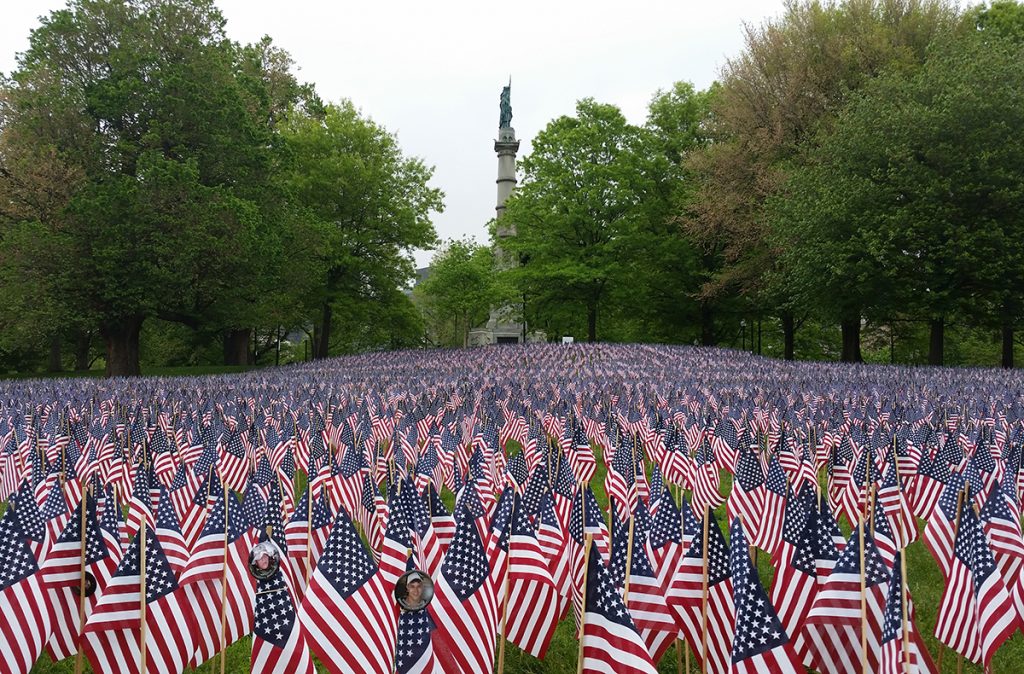
Massachusetts Military Heroes Garden of Flags. Via Boston Magazine.
Boston suffered an economic decline after World War II. Spurred by federal programs encouraging “urban renewal,” the West End was demolished to make way for the “new” Boston: Boston City Hall and its windswept plaza. There is a tribute to the demise of the West End tucked along New Chardon Street. The first computer-generated sculpture made of Cor-Ten steel, Computersphere (1995), by Alfred Duca, represents a wrecking ball just like the ones used to demolish the West End.
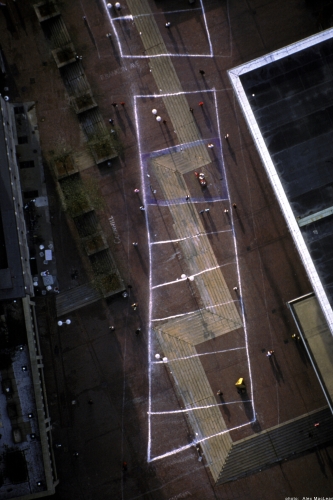
Gretchen Schneider, Making Time Visible. Via Culture Now.
In 2003, on City Hall Plaza (once the site of Scollay Square the heart of Boston’s West End), Making Time Visible transformed the site into a to-scale street map of what the site looked like in 1903. The project was conceived by artist and architect Gretchen Schneider, who worked with volunteers and students from Citizen Schools. The work highlighted Boston’s changing landscape and engaged the public to walk in the recreated streets. Notations were made, pointing out important points of interest, such as the offices of William Lloyd Garrison, where he published The Liberator, and the studios of Thomas Edison and Alexander Graham Bell.
In early 2000, a group of advocates and their clients approached Boston Reality, who had just purchased the Saltonstall Building at 100 Cambridge Street for development. The group presented a proposal for a memorial in the open space tucked between the building and the Suffolk Court House. Under the expert hand of landscape architect Catherine Melina the Garden of Peace (2004) was created. This is a beautiful, landscaped living garden created for the families to honor their relatives, the victims of Boston homicides. In lesser hands it might be just another park with benches and a sculpture of some kind, but Melina created a contemplative garden designed solely as relief for families who spend months, and sometimes years, attending hearings concerning their loved ones’ murders. The garden is laid out as a meditation to heal from their grief.
Each element of Garden of Peace represents the grieving process. At the entrance is the 17-foot Ibis Ascending by Judy McKie showing three ibis taking flight. The sculpture is located in a pool, representing the potential for peace. The river flows into a dry river stream of worn river stones engraved with the names of homicide victims with their dates of birth and death. It curves through the garden and culminates with a trickle of water in a pool. Each stone is different, as unique as the life of the person whose name it bears and reflects the enormous loss. Sadly, each September they hold an Honor Program adding new names of homicide victims to the dry river stone bed.
Sometimes the impact of an event subsides as memories fade and priorities rearrange our thinking about events. The Boston Public Garden’s first public artwork, a fountain, is dedicated to the anesthesia ether. The facts of this memorial bring it alive for me; it’s hard to believe that anesthesia wasn’t used for surgery until1846, twenty-five years after Massachusetts General Hospital began to treat patients. That fateful year, Boston dentist William Thomas Green Morton gave the first successful demonstration showing the position affects of anesthesia ether on patients during surgery. Inspired by this successful discovery, philanthropist Thomas Lee donated funds for a fountain to be placed in the Boston Public Garden “...in gratitude for the relief of human suffering by the inhaling of Ether.”
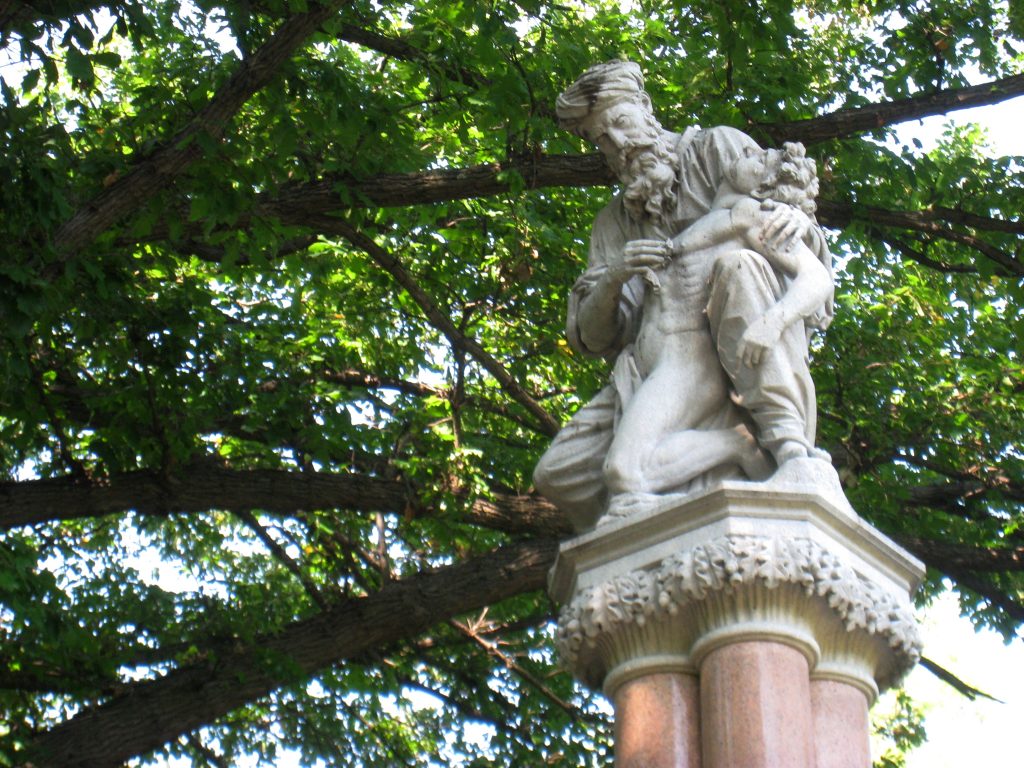
Ether Monument in Boston Public Garden. Via Wikipedia.
While it may seem odd now to celebrate ether, had you lived on Beacon Hill as Mr. Lee did, you would have experienced first hand, along with your neighbors, the bone chilling screams that echoed through the streets by Mass General patients. Of course, ether was not an unknown element. For Victorians it was quite a party drug, a substance that allowed you to not feel pain or remember anything when you woke up the next day. So it was only a matter of time before someone saw a positive use and put it into effect. The original idea for the monument was to show a heroic Mr. Morton as father of the discovery. However, shortly after Mr. Morton’s discovery was announced, another Boston dentist, Charles T. Jackson, claimed Morton had stolen his breakthrough with ether. Years of court battles ensued. As the two dentists duked it out in the press, the concept for the fountain was reconsidered.
Ultimately it was decided neither man would be mentioned. Instead, the artist John Quincy Adams Ward chose the parable of the Good Samaritan to top the fountain, and then surrounded the base with bas-relief medical scenes carved in marble. Upon its dedication, Oliver Wendell Holmes wrote it was a tribute “to ether – or either”.
One never knows what the outcome will be when a permanent artwork is added to the landscape. The humorous whirligig Traffic by George Greenamyer in Roslindale Square was inspired by his difficulty maneuvering the street traffic as he tried to visit the site for inspiration. The piece has proven to be a popular community landmark. Other pieces like Landwave in the South End were designed before the neighborhood saw its development boom, which has transformed a quiet park corner into a rambunctious Little League softball field. The original design replicated the shoreline creating a landscaped ribbon of glass tiles and plantings. But with kids running up the sides, stray softballs pulverizing the tiles, and plantings not able to establish, it stays in a constant state of disrepair. Short of fencing its perimeter there seems no way to salvage the piece that now seems no longer appropriate for the space.
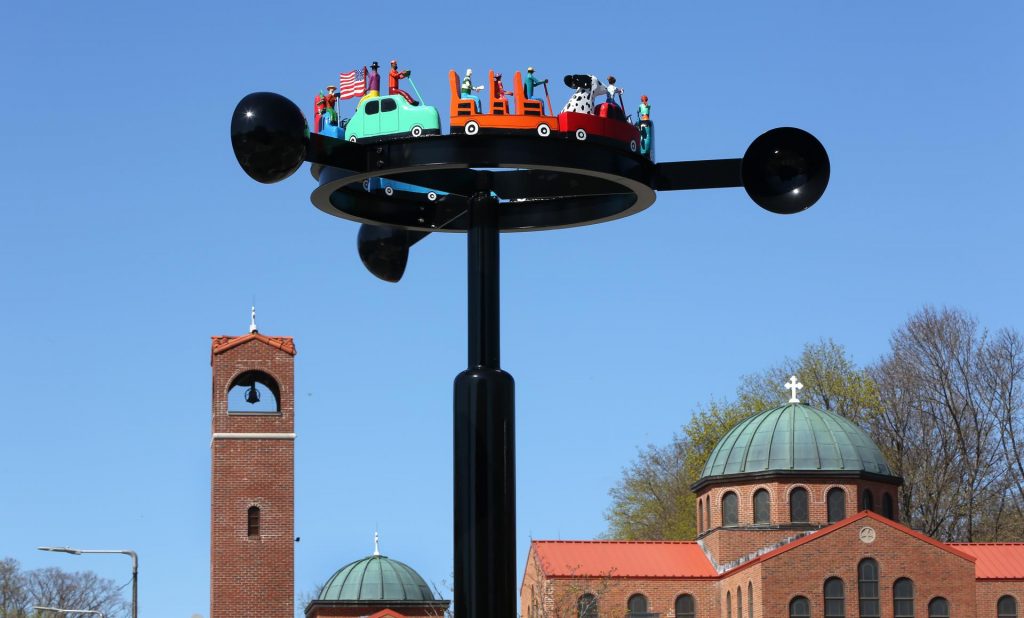
George Greenamyer, Traffic. Via the Boston Globe.
Later this spring, the Massachusetts Iraq and Afghanistan Fallen Heroes Memorial will be unveiled in the Seaport neighborhood of South Boston. One has to wonder what its future will hold. How will the stories of these men and women continue to be told as the memory of this time passes? Will the structure itself continue to hold you in awe and cause you to feel the enormity of their sacrifice and will it become a place where the community can relax and enjoy a sunny day? Only time will tell.

